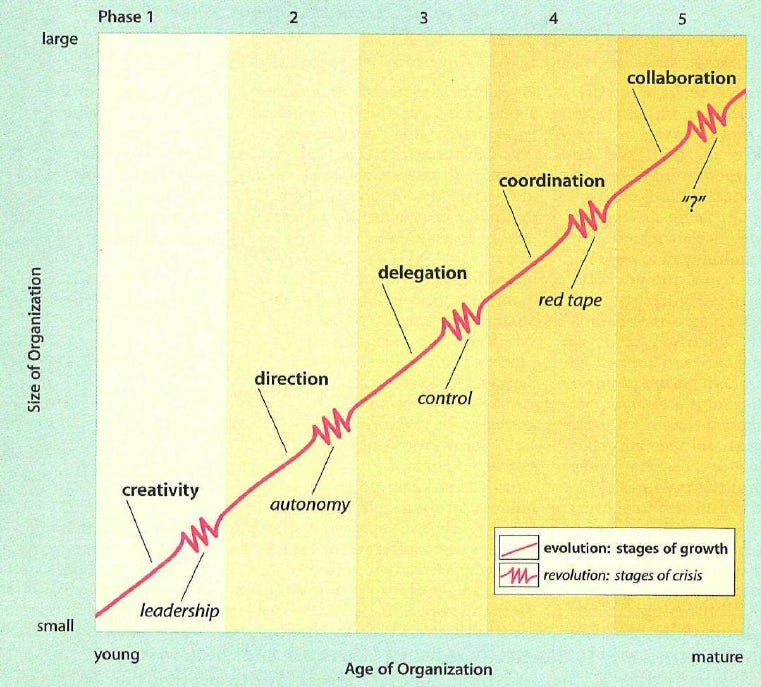The six crises every organization faces [corrected image]
Each phase of growth solves one problem—and creates the next. Here's the cycle organizations repeat.
My last email didn’t include the image. Whoops! So… I’m resending the email again.
Also — I’m taking on 1-2 new clients this summer! See my consulting work here. If you know anyone who’s building a growing team or navigating structural change, send them my way: timcasasola@gmail.com.
I recently picked up Levers of Organization Design. The first chapter introduces “Evolution and Revolution as Organizations Grow,” a model developed in 1972 by Larry Greiner, a professor at USC.
I was intrigued! As organizations grow, they encounter crises, solve for those crises, and introduce new crises from the solutions that were implemented before. It’s a good tool to help organizations get more prepared for the inevitable problems that occur as they grow.

Evolution and Revolution, Summarized
All organizations start small and young. Creativity is what drives growth. Everyone is a jack-of-all-trades, the entrepreneurial spirit is high, they’re excited to get a product/service in the market.
The growth makes things feel chaotic. Roles become more and more unclear. They miss a lot of potential opportunities.
They experience a crisis in leadership. So they instill more direction.
A structured hierarchy is introduced. Perhaps a new leader from a more established company is brought in to bring in systems and structures. Distinct functions are created: brand marketing, product operations, engineering, design, finance, HR. The company resumes its growth.
But then these functions become insulated from the marketplace. The business that once had a direct relationship with their customers now lose touch with them. Employees start to check out. It’s not fun to work there.
They experience a crisis in autonomy. So they embrace delegation.
“We need to push decision-making authority to the teams closest to the problem.” They bring in org design consultants (👋🏽) to decentralize their structure and form cross-functional teams. Standalone business teams are formed. Innovation is reignited, teams are encouraged to test and learn, and teams improve their ways of working to respond to customer needs. Growth resumes.
But then… the decentralized structure creates independent fiefdoms. Business leads have conflicting priorities, tradeoffs aren’t being made, and none of it adds up to a cohesive strategy. Coordination gets harder, budget is wasted, and profitability declines.
It’s a crisis of control. So then they grow through coordination.
Centralized coordination systems are brought back in. Head office/corporate/the C-suite reigns control. Program managers are hired. New centralized staff groups assume responsibility for planning, coordination, and resource allocation. Business leads now have to get approval from headquarters before pursuing a new strategic commitment. Things feel bureaucratic—again.
It becomes a crisis of red tape. So then they grow through collaboration.
Consultants are brought in again to reduce friction in the way they work (👋🏽). It’s all about teamwork. Let’s cut through the bureaucracy. Investments towards noncore business offerings are cut and the business refocuses on its core offering. Centralized staff groups are dismantled. They emphasize that business teams have direct accountability for results.
But then… coordination suffers again! The collaborative culture that once fueled momentum now slows everything down. Decisions drag. Ownership blurs. Meetings multiply, but outcomes don’t. Cross-team initiatives stall without clear accountability. As the organization grows—even globally—its internal complexity starts to outpace its ability to execute. Growth plateaus. Teams duplicate efforts or move in conflicting directions. People feel stuck.
It’s a crisis of growth. So they embrace alliances.
They acquire new capabilities, invest in AI, build strategic partnerships, and/or expand through joint ventures. It works—until it doesn’t. The business now spans industries, geographies, and business models. And with that comes a new kind of crisis: a crisis of identity.
They go back to the basics. Who are we? What’s our vision? Mission? What impact do we want to make? How will we win as a business? What obstacles stand in our way—and what will it take to overcome them?
Aren’t they just flip flopping?
Instead of growth being a linear journey, I wonder if growth just forces organizations to flip flop between two states: Centralized and Decentralized. Are organizations vacillating between a centralized structure with specialized functions and a decentralized structure with cross-functional team?
Both structures have their pros and cons.
It’s easier to get things done in a centralized structure, but harder to respond to the market, try new bets, and pursue new opportunities.
It’s easier to respond to market and place new bets in a decentralized structure, but harder to coordinate across business teams.
Maybe it’s just another way to look at it.
Making it useful and thinking about now
However you look at it, I think you can make this model useful for your organizational context. If you’re part of a leadership team, ask your team:
If we were in a stage in this model, what stage are we in? What have we seen that tells us we’re in this stage?
Given that we’re in this stage, what crisis might we encounter? What tensions are signs that this crises is bound to happen (or is happening right now)?
What might we need to change to prepare for the challenges ahead?
I’m curious what now might tell us about this model. With rapid advancements in AI, what new crises are on the horizon for companies that heavily investing in AI? Will we these companies experience any of these crises? Or will new crises occur?



